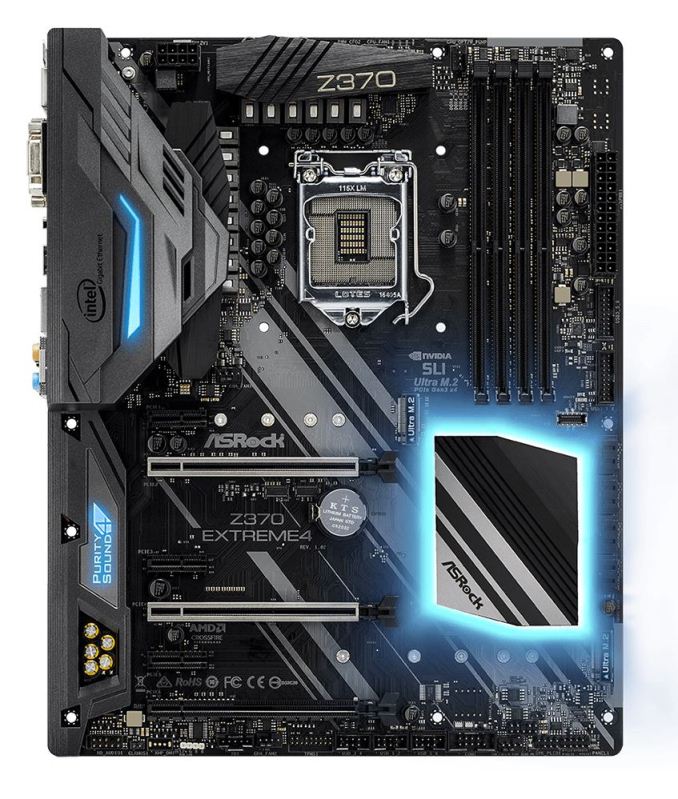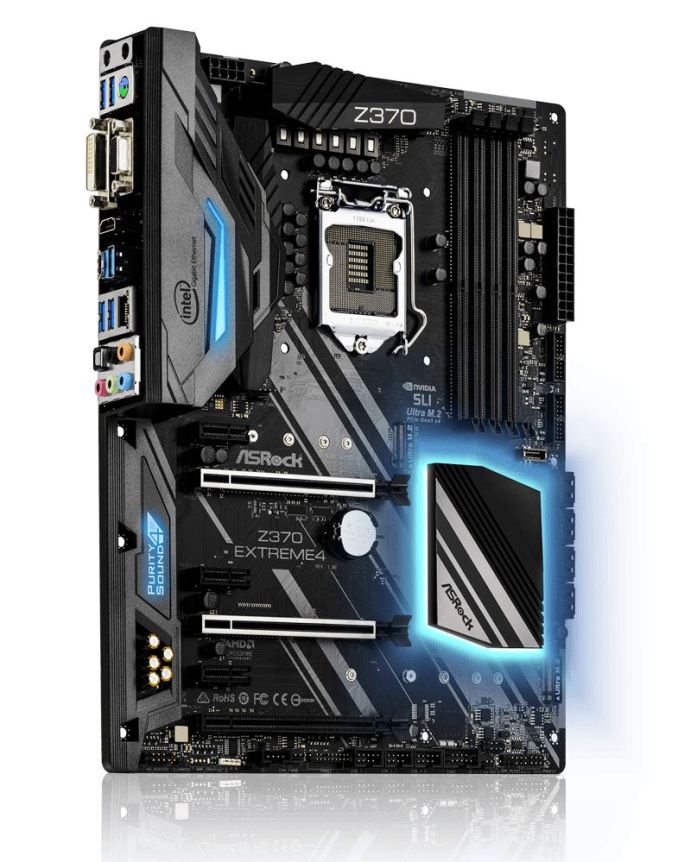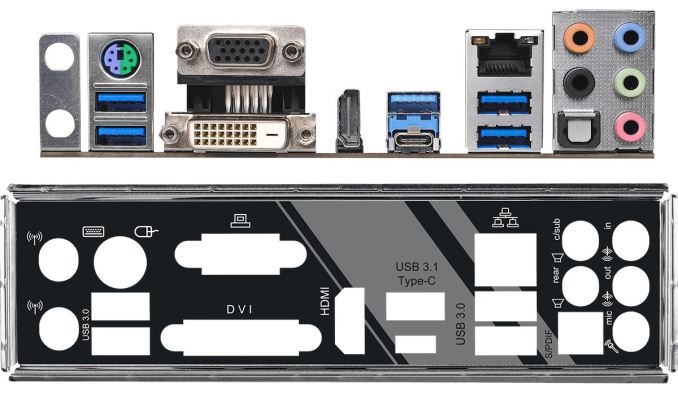Analyzing Z370 for Intel's 8th Generation Coffee Lake: A Quick Look at 50+ Motherboards
by Ian Cutress, Anton Shilov, Joe Shields & Gavin Bonshor on October 20, 2017 2:00 PM ESTASRock Z370 Extreme4
The ASRock Extreme4 is the flagship in the Extreme lineup, offering some of the same features as the Fatal1ty Gaming line. It uses the same flavor of power delivery with 60A chokes, Nichicon Combo caps, and Dual-Stack MOSFETs. What is missing on the overclocking front is the Hyper BCLK generator, so the range in which one can adjust the BCLK may not be as wide. This shouldn’t be a big issue for most considering the unlocked CPUs which will likely find their way into this socket.
The Z370 Extreme4 uses an all-black PCB with a few ‘racing’ stripes running through the board from the top left to the bottom right through the PCIe area and chipset heatsink. The Extreme4 uses the same shape and style VRM heatsinks found on the high-end boards, albeit without a heatpipe connecting them. The same style shrouding over the back panel and audio section is carried over from the flagship, and contains RGB LED features as well. The chipset heatsink is different, a bit more basic, and has RGB LEDs underneath. All the RGB LEDs, including the RGB header, can be controlled with ASRock RGB LED software.
Supported memory speeds on the Extreme4 reach up to DDR4-4333, with up to a 64 GB capacity. The top two slots are from the processor, and use reinforcement for holding heavy GPUs. The lane breakdown should be familiar with x16 cards single and x8/x8 in dual mode, while the final non-reinforced full-length PCIe slot has an additional PCIe x4 bandwidth from the chipset. There are also three x1 slots from the chipset.
Eight SATA ports are found on the board, with six using the chipset and another two using the ASM1061 (which uses a chipset PCIe x1 connection to create the two additional SATA ports). Two M.2 slots are found on the board with the top supporting up to an 80mm drive and the bottom supports 110mm drives. Lane sharing is required here when SATA drives are in play, with SATA ports 0/1 disabled when the first M.2 slot is used and the SATA 4/5 ports are disabled when the second M.2 slot is used.
Fan control is handled through the BIOS or via the F-Stream software, and it gives control to all the 4-pin headers: A CPU fan header (1A/12W), 2 chassis fan headers, and a chassis optional/water pump header (1.5A/18W). Audio duties are taken by the latest ALC1220 codec, which uses Nichicon Gold series audio caps, a Texas Instruments NE5532 headset amplifier, and the whole audio subsystem has PCB separation of the audio components from the rest of the board. Network functionality is handled by a single Intel I219-V network controller.
There are two USB 3.1 (10 Gbps) Type-A and Type-C ports on the rear panel via an ASM3142 controller, and four USB 3.1 (5 Gbps) ports fed from the chipset. Internally there are an additional three headers for USB 2.0 providing 6 ports, and two headers for USB 3.1 5Gbps support driven by the chipset or ASM1074 hub. There is also an additional new generation USB header, but this looks like it is only at 5 Gbps. The rest of the back panel consists of space for a Wi-Fi antenna in the E-key space, a combination PS/2 port, D-Sub, DVI-D, and HDMI ports for video output, and the 5 plug plus SPDIF audio stack.
| ASRock Z370 Extreme4 | |
| Warranty Period | 3 Years |
| Product Page | Link |
| Price | Amazon US |
| Size | ATX |
| CPU Interface | LGA1151 |
| Chipset | Intel Z370 Express |
| Memory Slots (DDR4) | Four DDR4 Supporting 64GB Dual Channel Support DDR4 4333+ |
| Network Connectivity | 1 x Intel I219-V GbE |
| Onboard Audio | Realtek ALC1220 |
| PCIe Slots for Graphics (from CPU) | 2 x PCIe 3.0 x16 slots @ x16 or x8/x8 |
| PCIe Slots for Other (from Chipset) | 1 x PCIe 3.0 x16 slots @ x4 3 x PCIe 3.0 x1 slots |
| Onboard SATA | 6 x Chipset 2 x ASM1061) |
| Onboard SATA Express | None |
| Onboard M.2 | 3 x PCIe 3.0 x4 - NVMe or SATA |
| Onboard U.2 | N/A |
| USB 3.1 (10 Gbps) | 1 x Type-C (ASMedia) 1 x Type-A (ASMedia) |
| USB 3.0 (5 Gbps) | 4 x Rear Panel 1 x Header 1 x ASM1074 Header |
| USB 2.0 | 3 x Headers |
| Power Connectors | 1 x 24-pin EATX 1 x 8-pin ATX 12V |
| Fan Headers | 1 x 4-pin CPU 1 x 4-pin Waterpump (1.5A/18W) 2 x 4-pin Chassis Fan 1 x Chassis Optional/Water Pump (1.5A/18W) |
| IO Panel | 2 x Wi-Fi Antenna ports 1 x PS/2 keyboard/mouse port 1 x HDMI port 1 x D-Sub port 1 x DVI-D port 1 x Optical SPDIF Out Port 1 x USB 3.1 (10 Gbps) Type-C 1 x USB 3.1 (10 Gbps) Type-A 4 x USB 3.1 (5 Gbps) Type-A ports 1 x LAN (RJ45) ports 1 x Optical S/PDIF out 5 x Audio Jacks |













83 Comments
View All Comments
sor - Friday, October 20, 2017 - link
Damn. At least key it differently and call it LGA1151v2 or something.The changes are so minimal it really does seem like planned obsolescence. Does it really need more power pins to support new chips with the same power envelopes? Really? They couldn’t handle that on the CPU PCB?
KaarlisK - Saturday, October 21, 2017 - link
Actually it is ~1.5 times peak current with the same average power envelope, so yes, they need the change.If they had not brought the launch forward and just launched together with the cheap chipsets, there would be far less complaints.
sor - Saturday, October 21, 2017 - link
Where did you find information indicating current has increased 50%? I just spent about ten minutes trying to find a reference backing that up, perhaps something indicating the 8 series operates at a much lower voltage within same TDP, which would translate to higher current but they seem to operate in the same 1.2-1.3v range.You’re not just assuming they draw more current because they have two more cores, are you?
KaarlisK - Sunday, October 22, 2017 - link
Notice the difference between average and peak.And the information is in publicly available documents. I did not bother to look it up, but others have, for example: https://forum.beyond3d.com/threads/intel-coffee-la...
Crono - Saturday, October 21, 2017 - link
Nice roundup. That's a lot of motherboards to spec and summarize. I especially appreciate the handy chart at the end, it's a good, quick-and-dirty comparison tool.Landcross - Saturday, October 21, 2017 - link
You guys forgot 2 new Z370 boards from Supermicro :)https://motherboarddb.com/motherboards/?chipset=19...
Xpl1c1t - Sunday, October 22, 2017 - link
The mITX board looks incredible.+ Low ESR Tantalum capacitors! (first time seeing them on VRM duty on a mainboard)
+ HDMI 2.0
+ 2x M.2 Slots
+ USB 3.1 Type C
+ Optical SPDIF
- RGB.......
MadAd - Saturday, October 21, 2017 - link
Great write up but for me its just another depressing generation of oversized, overpriced ATX form factor offerings on which the vast majority of users wont even plug a second gpu into, with the smaller and more size appropriate FF represented as a minority afterthought.With all the progress of PCs since the 90s whod have thought that I could still use the same ATX case today while every single other component (from floppy drives to 2d Mattrox cards) have long gone to the recyclers. I find it so annoying how manufacturers have stuck on this prehistoric gargantuan case size with the other sizes being an afterthought. It feels like like stifled innovation while everything else is moving on.
rocky12345 - Saturday, October 21, 2017 - link
Great article and a lot of work put in to get it out for us to read thank you.My only issue is and it is nit your fault is why these companies feel the need to totally blanket the market with basically the same boards just a different model number and basically a few tiny changes and spray paint it a different color and use the word gaming and put something x or x1 or k,k3 etc etc. For crap sakes just release three models not 7-10 models of the same crap it is pretty much just greed I guess.
The whole market is like this now with anything computer related of and if it has the words GAMING or RGB in it's got to be good for sure. My fav is that gaming mouse pad next it will have RGB lighting in it...lol
CitizenZer0 - Wednesday, October 25, 2017 - link
Agreed